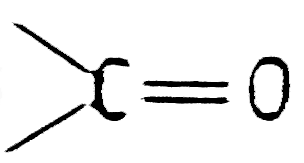Alkenes and carbonyl compounds both contain a π bond but alkenes show electrophilic addition reaction whereas carbonyl compounds show nucleophilic addition reactions. Explains.
Text Solution
In alkenes, the double bond is formed between two carbon atoms. There is no polarity in the bond. Butit polarises molecules like Cl2,HCl,H2O etc., resulting it in the attachment of electrophile to one of the carbon atoms.
In carbonyl compounds, the double bond is between C and O. Oxygen being electronegative than carbon, the latter attains a slight positive charge. This positive carbon attracts the nucleophile giving rise to nucleophilic addition reactions.
|
Topper's Solved these Questions
- ALDEHYDES, KETONES AND CARBOXYLIC ACIDSBOOK - U-LIKE SERIESCHAPTER - ALDEHYDES, KETONES AND CARBOXYLIC ACIDSEXERCISE - LONG ANSWER QUESTIONS - I
29 Videos
- ALDEHYDES, KETONES AND CARBOXYLIC ACIDSBOOK - U-LIKE SERIESCHAPTER - ALDEHYDES, KETONES AND CARBOXYLIC ACIDSEXERCISE - LONG ANSWER QUESTIONS - II
44 Videos
- ALDEHYDES, KETONES AND CARBOXYLIC ACIDSBOOK - U-LIKE SERIESCHAPTER - ALDEHYDES, KETONES AND CARBOXYLIC ACIDSEXERCISE - VERY SHORT ANSWER QUESTIONS
53 Videos
- ALCOHOLS, PHENOLS AND ETHERSBOOK - U-LIKE SERIESCHAPTER - ALCOHOLS, PHENOLS AND ETHERSEXERCISE - SELF ASSESSMENT TEST (SECTION A)(MULTIPLE CHOICE QUESTIONS)(CHOOSE THE CORRECT OPTION)
6 Videos
- AMINESBOOK - U-LIKE SERIESCHAPTER - AMINESEXERCISE - SELF ASSESSMENT TEST
6 Videos
Similar Questions
Alkenes
 and carbonyl compounds
and carbonyl compounds  both contain a π bond but alkenes show electrophilic addition reactions whereas carbonyl compounds show nucleophilic addition reactions. Explain.
both contain a π bond but alkenes show electrophilic addition reactions whereas carbonyl compounds show nucleophilic addition reactions. Explain.
View SolutionAlkenes
 and carbonyl compounds
and carbonyl compounds  both contain a π bond but alkenes show electrophilic addition reactions whereas carbonyl compounds show nucleophilic addition reactions. Explain.
both contain a π bond but alkenes show electrophilic addition reactions whereas carbonyl compounds show nucleophilic addition reactions. Explain.
View Solution
Knowledge Check
Carbonyl compounds undergo nucleophilic addition because of :
Aelectronegativity difference of carbon and oxygen atomsBelectromeric effect.Cmore stable anion with negative charge on oxygen and less stables carbocationDnone of theseSelect the least reactive carbonyl compound for nucleophilic addition
A B
B C
C DCH3CHO
DCH3CHOThe order of reactivity of carbonyl compounds for nucleophilic addition is
AAr2C=O>R2C=O>ArCHO>RCHO>H2C=OBH2C=O>R2C=O>Ar2C=O>RCHO>ArCHOCH2C=O>RCHO>ArCHO>R2C=O>Ar2C=ODArCHO>Ar2C=O>RCHO>R2C=O>H2C=O
Describe two nucleophilic addition reactions of carbonyl compounds.
View SolutionWhy do alkenes undergo electrophilic addition reactions ?
View SolutionWhy do alkenes undergo electrophilic addition reactions ?
View SolutionDiscuss the relative reactivities of carbonyl compounds in nucleophilic addition reactions.
View SolutionCarbonyl compounds undergo nucleophilic addition because of :
View Solution
